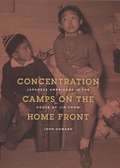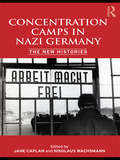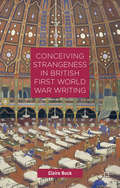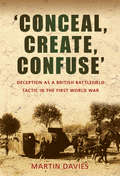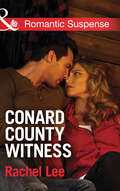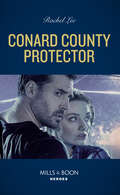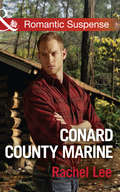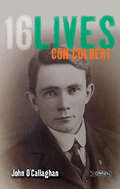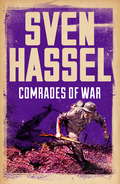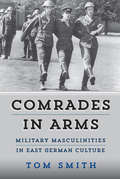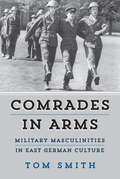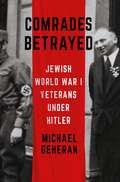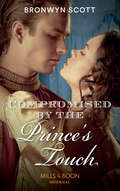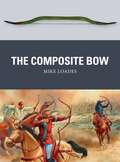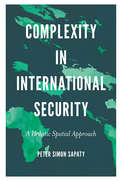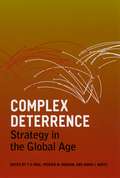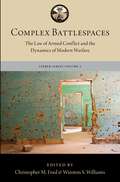- Table View
- List View
Concentration Camps on the Home Front: Japanese Americans in the House of Jim Crow
by John HowardWithout trial and without due process, the United States government locked up nearly all of those citizens and longtime residents who were of Japanese descent during World War II. Ten concentration camps were set up across the country to confine over 120,000 inmates. Almost 20,000 of them were shipped to the only two camps in the segregated South—Jerome and Rohwer in Arkansas—locations that put them right in the heart of a much older, long-festering system of racist oppression. The first history of these Arkansas camps, Concentration Camps on the Home Front is an eye-opening account of the inmates’ experiences and a searing examination of American imperialism and racist hysteria. While the basic facts of Japanese-American incarceration are well known, John Howard’s extensive research gives voice to those whose stories have been forgotten or ignored. He highlights the roles of women, first-generation immigrants, and those who forcefully resisted their incarceration by speaking out against dangerous working conditions and white racism. In addition to this overlooked history of dissent, Howard also exposes the government’s aggressive campaign to Americanize the inmates and even convert them to Christianity. After the war ended, this movement culminated in the dispersal of the prisoners across the nation in a calculated effort to break up ethnic enclaves. Howard’s re-creation of life in the camps is powerful, provocative, and disturbing. Concentration Camps on the Home Front rewrites a notorious chapter in American history—a shameful story that nonetheless speaks to the strength of human resilience in the face of even the most grievous injustices.
Concentration Camps in Nazi Germany: The New Histories
by Jane Caplan Nikolaus WachsmannThe notorious concentration camp system was a central pillar of the Third Reich, supporting the Nazi war against political, racial and social outsiders whilst also intimidating the population at large. Established during the first months of the Nazi dictatorship in 1933, several million men, women and children of many nationalities had been incarcerated in the camps by the end of the Second World War. At least two million lost their lives. This comprehensive volume offers the first overview of the recent scholarship that has changed the way the camps are studied over the last two decades. Written by an international team of experts, the book covers such topics as the earliest camps; social life, work and personnel in the camps; the public face of the camps; issues of gender and commemoration; and the relationship between concentration camps and the Final Solution. The book provides a comprehensive introduction to the current historiography of the camps, highlighting the key conclusions that have been made, commenting on continuing areas of debate, and suggesting possible directions for future research.
Concentration Camps in Nazi Germany: The New Histories
by Nikolaus Wachsmann Jane CaplanThe notorious concentration camp system was a central pillar of the Third Reich, supporting the Nazi war against political, racial and social outsiders whilst also intimidating the population at large. Established during the first months of the Nazi dictatorship in 1933, several million men, women and children of many nationalities had been incarcerated in the camps by the end of the Second World War. At least two million lost their lives. This comprehensive volume offers the first overview of the recent scholarship that has changed the way the camps are studied over the last two decades. Written by an international team of experts, the book covers such topics as the earliest camps; social life, work and personnel in the camps; the public face of the camps; issues of gender and commemoration; and the relationship between concentration camps and the Final Solution. The book provides a comprehensive introduction to the current historiography of the camps, highlighting the key conclusions that have been made, commenting on continuing areas of debate, and suggesting possible directions for future research.
Conceiving Strangeness in British First World War Writing
by C. BuckThis book reframes British First World War literature within Britain's history as an imperial nation. Rereading canonical war writers Siegfried Sassoon and Edmund Blunden, alongside war writing by Enid Bagnold, E. M. Forster, Mulk Raj Anand, Roly Grimshaw and others, the book makes clear that the Great War was more than a European war.
'Conceal, Create, Confuse': Deception as a British Battlefield Tactic in the First World War
by Martin DaviesThis is the story of the British Army's endeavours during the Great War to deceive the enemy and trick him into weakening his defences and redeploying his reserves. In this year-by-year account, Martin Davies shows how Sir John French and Sir Douglas Haig actively encouraged their Army commanders to employ trickery so that all attacks should come as a 'complete surprise' to the enemy. The methods of concealment of real military artefacts and the creation of dummy ones were ingenious enough but the real art lay in the development of geographically dispersed deception plans which disguised the real time and place of attack and forced the enemy to defend areas threatened by fake operations. Some of these plans, such as disguising mules as tanks and creating dummy airfields bordered on the farcical but were often amazingly effective. The driving force behind the deception plans was GHQ and the Army commanders, further dispelling the myth of 'Lions led by Donkeys'. Evidence shows that the British Army employed deception to advantage in all their theatres of operation.
Conard County Witness: Conard County Witness His Christmas Assignment Agent Gemini Risk It All (Conard County: The Next Generation #27)
by Rachel LeeStalked by a relentless killer…
Conard County Protector (Conard County: The Next Generation #53)
by Rachel LeeBack in town, and back under fire
Conard County Marine: Conard County Marine High-stakes Colton Cold Case Recruit Safe In His Sight (Conard County: The Next Generation #31)
by Rachel LeeFrom New York Times bestselling author Rachel Lee comes a story of one woman's survival and her protector's promise to find answers
Con Colbert: 16Lives (16lives Ser. #12)
by John O'CallaghanCon Colbert was one of the lesser-known leaders of the 1916 Rising. From a comfortable background in Newcastlewest, County Limerick, he moved to Dublin aged fifteen and worked as a junior clerk in a bakery. Already politically radicalised, he became captain of the first troop of Na Fianna Éireann, the republican boy-scout movement. An unswerving patriot and idealist, he worked tirelessly for the dream of an Irish-speaking, independent republic. Even before his execution, Colbert was held up as an icon and a role model for the Irish Volunteers. Colbert commanded a company at Watkins’ Brewery and at Jameson’s Distillery during the Rising. Inspiring men by example, he showed no fear in the face of danger and confronted his own death with equanimity. Con Colbert was executed at Kilmainham Gaol on 8 May 1916, aged twenty-seven.
Comrades of War (Sven Hassel War Classics)
by Sven HasselThere were not so much people as animals. Sometimes small and frightened, huddling together in cattle cars, wounds gaping, tongues swelling even as they licked the moist frost from the walls...Grievously wounded - having survived the operating table and the perilous journey West on a freezing freight train - Sven Hassel and his comrades find themselves behind the lines in a Hamburg hospital. The Reich is a hotbed of lies, betrayal and propaganda. Disgusted by the Nazi cause, the comrades drink themselves into oblivion, visit brothels where women dance naked on saloon tables and reach for home comforts before they return to the dreaded Russian Front. Because Hitler's war must go on... COMRADES OF WAR is a gritty portrayal of war's harsh realities and the fear and fanaticism at the heart of The Third Reich.Sven Hassel's unflinching narrative is based on his own experiences in the German Army. He began writing his first novel, LEGION OF THE DAMNED in a prisoner of war camp at the end of the Second World War.
Comrades in Arms: Military Masculinities in East German Culture
by Tom SmithWithout question, the East German National People’s Army was a profoundly masculine institution that emphasized traditional ideals of stoicism, sacrifice, and physical courage. Nonetheless, as this innovative study demonstrates, depictions of the military in the film and literature of the GDR were far more nuanced and ambivalent. Departing from past studies that have found in such portrayals an unchanging, idealized masculinity, Comrades in Arms shows how cultural works both before and after reunification place violence, physical vulnerability, and military theatricality, as well as conscripts’ powerful emotions and desires, at the center of soldiers’ lives and the military institution itself.
Comrades in Arms: Military Masculinities in East German Culture
by Tom SmithWithout question, the East German National People’s Army was a profoundly masculine institution that emphasized traditional ideals of stoicism, sacrifice, and physical courage. Nonetheless, as this innovative study demonstrates, depictions of the military in the film and literature of the GDR were far more nuanced and ambivalent. Departing from past studies that have found in such portrayals an unchanging, idealized masculinity, Comrades in Arms shows how cultural works both before and after reunification place violence, physical vulnerability, and military theatricality, as well as conscripts’ powerful emotions and desires, at the center of soldiers’ lives and the military institution itself.
Comrades Betrayed: Jewish World War I Veterans under Hitler (Battlegrounds: Cornell Studies in Military History)
by Michael GeheranAt the end of 1941, six weeks after the mass deportations of Jews from Nazi Germany had begun, Gestapo offices across the Reich received an urgent telex from Adolf Eichmann, decreeing that all war-wounded and decorated Jewish veterans of World War I be exempted from upcoming "evacuations." Why this was so, and how Jewish veterans at least initially were able to avoid the fate of ordinary Jews under the Nazis, is the subject of Comrades Betrayed. Michael Geheran deftly illuminates how the same values that compelled Jewish soldiers to demonstrate bravery in the front lines in World War I made it impossible for them to accept passively, let alone comprehend, persecution under Hitler. After all, they upheld the ideal of the German fighting man, embraced the fatherland, and cherished the bonds that had developed in military service. Through their diaries and private letters, as well as interviews with eyewitnesses and surviving family members and records from the police, Gestapo, and military, Michael Geheran presents a major challenge to the prevailing view that Jewish veterans were left isolated, neighborless, and having suffered a social death by 1938. Tracing the path from the trenches of the Great War to the extermination camps of the Third Reich, Geheran exposes a painful dichotomy: while many Jewish former combatants believed that Germany would never betray them, the Holocaust was nonetheless a horrific reality. In chronicling Jewish veterans' appeal to older, traditional notions of comradeship and national belonging, Comrades Betrayed forces reflection on how this group made use of scant opportunities to defy Nazi persecution and, for some, to evade becoming victims of the Final Solution.
Compromised By The Prince’s Touch: His Convenient Marchioness Compromised By The Prince's Touch The Captain's Disgraced Lady (Russian Royals of Kuban #1)
by Bronwyn ScottAn irresistible royal seduction… Daring Prince Nikolay Baklanov feels London is worlds away from his life of battle and revolution in Kuban. But then the Russian ambassador’s daughter, beautiful Klara Grigorieva, approaches him with her father’s dangerous proposition…
Compromised (Alpha Ops #5)
by Emmy CurtisIt was supposed to be the happiest day of her life. But when her wedding erupts in gunfire, Sadie Walker realizes this is not the life she wants-her fiancé's work with Delta Force will always cast a shadow over their relationship. After leaving the hard-muscled hero at the altar, she thinks she'll never see him again . . . until a chance encounter reveals that he still has a strong grip on her heart. On a covert assignment overseas, Simon Tennant is shocked when he spots Sadie with another man. Jealousy flares, as does an irresistible urge to keep her protected. Amid a dangerous game of international espionage, he'll have to convince Sadie just how perfect they've always been together. This time, nothing will take precedence over winning her back, no matter the cost to his cover-or his life . . . Alpha Ops Series: Book 1: Dangerous Territory (novella)Book 2: Over the LineBook 3: Pushing the Limit Book 4: BlowbackBook 5: CompromisedBook 6: Risk of Exposure
The Composite Bow (Weapon)
by Peter Dennis Mike LoadesAn ancient design, emerging from Central Asia in the second millennium BC, the composite bow was adopted by a staggering variety of cultures, from nomadic tribal peoples such as the Huns, Turks and Mongols, to mighty empires such as the Romans, Byzantines, Persians, Arabs and Chinese. Offering high power and portability, the composite bow was an ideal cavalry weapon, though it was also used by infantry in open battle and as a siege weapon. In this important study, an expert on Eastern military technology tells the story of this extraordinary piece of military hardware; how it was made and how various cultures developed differing tactics for using it. He explains why the composite bow achieved such stunning successes and how it endured as a weapon of choice for thousands of years.
The Composite Bow (Weapon #43)
by Peter Dennis Mike LoadesAn ancient design, emerging from Central Asia in the second millennium BC, the composite bow was adopted by a staggering variety of cultures, from nomadic tribal peoples such as the Huns, Turks and Mongols, to mighty empires such as the Romans, Byzantines, Persians, Arabs and Chinese. Offering high power and portability, the composite bow was an ideal cavalry weapon, though it was also used by infantry in open battle and as a siege weapon. In this important study, an expert on Eastern military technology tells the story of this extraordinary piece of military hardware; how it was made and how various cultures developed differing tactics for using it. He explains why the composite bow achieved such stunning successes and how it endured as a weapon of choice for thousands of years.
A Complicated Matter: A historical novel of love, belonging and finding your place in the world by the Costa Book Award shortlisted author
by Anne YoungsonSet against the Blitz in London, a young woman's extraordinary journey of self-discovery and an intimate meditation on what it takes to find our place in the world.A March Best Book in Red'NOTE PERFECT' East Riding Magazine'AN EXTRAORDINARY NEW WRITER' Nina StibbeI used to believe the world had been created for me; every stone and grain of sand. As I grew older, I began to think of myself as something tacked on to the edge. 1939, London: From McPhail's Passage to Kensington's Grand Palace Hotel, Rose Dunbar is evacuated from her humble home on the Rock of Gibraltar and dropped into a chaotic city of falling bombs, perplexing class rules and bad weather. Despite being 'flagrantly foreign' to the locals, she becomes an efficient go-between for the upper-class ladies helping out with the war effort and her own tribe of noisy displaced families.It is only when she is shifted to the countryside to become secretary to the plain-speaking and sightless Major Inchbold that Rose's dizzying journey to womanhood will become more surreal than ever, as she drinks tea at the vicarage and stands up for the lower orders. But Rose's greatest dilemma is yet to come, as she must decide where her home - and her heart - really lies.In Anne Youngson's wry and sublimely understated prose, this unique and beautiful story of love, class and belonging is also a profound and intimate meditation on what it takes to find our place in the world.*******************************Praise for ANNE YOUNGSON: 'Tender, wise and moving, Meet Me at the Museum is a novel to cherish.' JOHN BOYNE'Insightful, emotionally acute and absorbing' DAILY EXPRESS'Beautiful and affecting' NINA STIBBEReaders love Anne Youngson's novels:'I was utterly gripped and felt bereft when I'd finished it' *****'I could not put this book down. An inspired approach to writing about life and love' *****'One of my top ten best reads of the year'*****
Complexity in International Security: A Holistic Spatial Approach
by Peter Simon SapatyIn September 2018, the 73rd General Assembly of the United Nations acknowledged that international instability is increasing and that improving global security is among the most important tasks facing the world today. The Assembly concluded that it is extremely important to develop new, effective frameworks and technologies to understand and confront increasingly complex networks of actors, interests, and contexts. Leading international security expert Peter Sapaty meets this challenge head-on and introduces a new, high-level distributed processing and control approach capable of finding real-time solutions for irregularities, crises, and security problems emerging any time and in any part of the world. Drawing upon the principles of Gestalt psychology, this book develops a radically new model of technology, Spatial Grasp Technology (SGT), a self-navigating, self-replicating, self-modifying spatial pattern technology expressed in a special high-level recursive language. Through rigorous theoretical argument and many practical examples, Sapaty shows how SGT can account for millions to billions of nodes distributed worldwide without vulnerable central resources; explains why SGT is hundreds of times shorter, simpler, and faster than other models and languages; and shows that SGT's technology basics are so simple that they can be effectively implemented even in a short time by a small group of system programmers within traditional university environments. Perhaps most importantly, Sapaty demonstrates how SGT is capable of implementing security scenarios not only at run time, but also conceivably ahead of it, allowing in some cases for the prediction and even prevention of local or global crises. For the novelty, simplicity, and wide applicability of its approach, Complexity in International Security is essential reading for system scientists, application programmers, industry managers, security and defence personnel, and university students interested in advanced MSc and PhD projects in the area of holistic and distributed management.
Complexity in International Security: A Holistic Spatial Approach
by Peter Simon SapatyIn September 2018, the 73rd General Assembly of the United Nations acknowledged that international instability is increasing and that improving global security is among the most important tasks facing the world today. The Assembly concluded that it is extremely important to develop new, effective frameworks and technologies to understand and confront increasingly complex networks of actors, interests, and contexts. Leading international security expert Peter Sapaty meets this challenge head-on and introduces a new, high-level distributed processing and control approach capable of finding real-time solutions for irregularities, crises, and security problems emerging any time and in any part of the world. Drawing upon the principles of Gestalt psychology, this book develops a radically new model of technology, Spatial Grasp Technology (SGT), a self-navigating, self-replicating, self-modifying spatial pattern technology expressed in a special high-level recursive language. Through rigorous theoretical argument and many practical examples, Sapaty shows how SGT can account for millions to billions of nodes distributed worldwide without vulnerable central resources; explains why SGT is hundreds of times shorter, simpler, and faster than other models and languages; and shows that SGT's technology basics are so simple that they can be effectively implemented even in a short time by a small group of system programmers within traditional university environments. Perhaps most importantly, Sapaty demonstrates how SGT is capable of implementing security scenarios not only at run time, but also conceivably ahead of it, allowing in some cases for the prediction and even prevention of local or global crises. For the novelty, simplicity, and wide applicability of its approach, Complexity in International Security is essential reading for system scientists, application programmers, industry managers, security and defence personnel, and university students interested in advanced MSc and PhD projects in the area of holistic and distributed management.
Complex Deterrence: Strategy in the Global Age
by T. V. Paul Patrick M. Morgan James J. WirtzAs the costs of a preemptive foreign policy in Iraq have become clear, strategies such as containment and deterrence have been gaining currency among policy makers. This comprehensive book offers an agenda for the contemporary practice of deterrence—especially as it applies to nuclear weapons—in an increasingly heterogeneous global and political setting. Moving beyond the precepts of traditional deterrence theory, this groundbreaking volume offers insights for the use of deterrence in the modern world, where policy makers may encounter irrational actors, failed states, religious zeal, ambiguous power relationships, and other situations where the traditional rules of statecraft do not apply. A distinguished group of contributors here examines issues such as deterrence among the Great Powers; the problems of regional and nonstate actors; and actors armed with chemical, biological, and nuclear weapons. Complex Deterrence will be a valuable resource for anyone facing the considerable challenge of fostering security and peace in the twenty-first century.
Complex Deterrence: Strategy in the Global Age
by T. V. Paul Patrick M. Morgan James J. WirtzAs the costs of a preemptive foreign policy in Iraq have become clear, strategies such as containment and deterrence have been gaining currency among policy makers. This comprehensive book offers an agenda for the contemporary practice of deterrence—especially as it applies to nuclear weapons—in an increasingly heterogeneous global and political setting. Moving beyond the precepts of traditional deterrence theory, this groundbreaking volume offers insights for the use of deterrence in the modern world, where policy makers may encounter irrational actors, failed states, religious zeal, ambiguous power relationships, and other situations where the traditional rules of statecraft do not apply. A distinguished group of contributors here examines issues such as deterrence among the Great Powers; the problems of regional and nonstate actors; and actors armed with chemical, biological, and nuclear weapons. Complex Deterrence will be a valuable resource for anyone facing the considerable challenge of fostering security and peace in the twenty-first century.
Complex Deterrence: Strategy in the Global Age
by T. V. Paul Patrick M. Morgan James J. WirtzAs the costs of a preemptive foreign policy in Iraq have become clear, strategies such as containment and deterrence have been gaining currency among policy makers. This comprehensive book offers an agenda for the contemporary practice of deterrence—especially as it applies to nuclear weapons—in an increasingly heterogeneous global and political setting. Moving beyond the precepts of traditional deterrence theory, this groundbreaking volume offers insights for the use of deterrence in the modern world, where policy makers may encounter irrational actors, failed states, religious zeal, ambiguous power relationships, and other situations where the traditional rules of statecraft do not apply. A distinguished group of contributors here examines issues such as deterrence among the Great Powers; the problems of regional and nonstate actors; and actors armed with chemical, biological, and nuclear weapons. Complex Deterrence will be a valuable resource for anyone facing the considerable challenge of fostering security and peace in the twenty-first century.
Complex Battlespaces: The Law of Armed Conflict and the Dynamics of Modern Warfare (The Lieber Studies Series)
by Michael N. Schmitt, Lieutenant Colonel Shane R. Reeves, Lieutenant Colonel Christopher M. Ford and Lieutenant Colonel Winston S. WilliamsThe conduct of warfare is constantly shaped by new forces that create complexities in the battlespace for military operations. As the nature of how and where wars are fought changes, new challenges to the application of the extant body of international law that regulates armed conflicts arise. This inaugural volume of the Lieber Studies Series seeks to address several issues in the confluence of law and armed conflict, with the primary goal of providing the reader with both academic and practitioner perspectives. Featuring chapters from world class scholars, policymakers and other government officials; military and civilian legal practitioners; and other thought leaders, together they examine the role of the law of armed conflict in current and future armed conflicts around the world. Complex Battlespaces also explores several examples of battlespace dynamics through four "lenses of complexity": complexity in legal regimes, governance, technology, and the urbanization of the battlefield.
Complex Battlespaces: The Law of Armed Conflict and the Dynamics of Modern Warfare (The Lieber Studies Series)
The conduct of warfare is constantly shaped by new forces that create complexities in the battlespace for military operations. As the nature of how and where wars are fought changes, new challenges to the application of the extant body of international law that regulates armed conflicts arise. This inaugural volume of the Lieber Studies Series seeks to address several issues in the confluence of law and armed conflict, with the primary goal of providing the reader with both academic and practitioner perspectives. Featuring chapters from world class scholars, policymakers and other government officials; military and civilian legal practitioners; and other thought leaders, together they examine the role of the law of armed conflict in current and future armed conflicts around the world. Complex Battlespaces also explores several examples of battlespace dynamics through four "lenses of complexity": complexity in legal regimes, governance, technology, and the urbanization of the battlefield.
